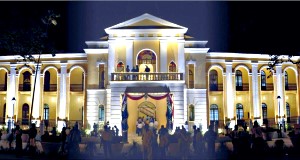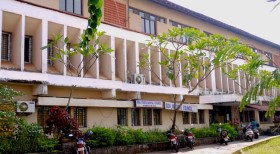Goa Medical College: Where some of Asia’s first doctors studied
Ever since Goa was made the permanent venue for the International Film Festival of India (IFFI) in 2004, each year in late November Bollywood bigwigs, international film personalities, and movie lovers from across India and the world descend on Goa’s capital city of Panjim to attend the star-studded event.
 During the ten-day extravaganza, while the city comes alive with the excitement and magic of film screenings and glittering ceremonies, the centre of attraction is the Palace of Maquineses (or Maquinezes) on the Campal promenade. The beautiful yellow ochre and white palace with its ornamental windows, attractive wooden balustrades, and Roman-style arches is bedecked with floral decorations and illuminated as one of the venues of the film festival.
During the ten-day extravaganza, while the city comes alive with the excitement and magic of film screenings and glittering ceremonies, the centre of attraction is the Palace of Maquineses (or Maquinezes) on the Campal promenade. The beautiful yellow ochre and white palace with its ornamental windows, attractive wooden balustrades, and Roman-style arches is bedecked with floral decorations and illuminated as one of the venues of the film festival.
But this beautiful former palace also has a historic significance. It was once the location of one of Asia’s oldest medical colleges – the Goa Medical College.
Established by the Portuguese as the Escola Médico-Cirúrgica de Nova Goa (Medical-Surgical School of Nova Goa) in 1842, it was also the only institution for higher education at that time anywhere in the Portuguese empire. (Nova Goa was the former name of Panjim.)
History of the Escola Médico-Cirúrgica de Nova Goa
However, western medicine was first taught in Goa much before the setting up of the college in Panjim. In 1591, Jesuit priests were asked to run the Royal Hospital that Afonso de Albuquerque had established soon after the conquest of Goa in 1510 where initially only Portuguese soldiers and officials were treated. The Jesuits went a step further and started a rudimentary medical school where the fisico-mor (chief physician) and cirurgiao-mor (chief surgeon) of the hospital taught medicine and surgery to interested candidates.
By the mid-18th century, different endemic diseases that ravaged Portugal’s overseas provinces in Africa and Asia resulted in the need for more doctors for the empire. Doctors from Portugal being reluctant to work in the colonies, the only other option was to impart medical training to the native people.
From 1770 to around 1794, troubled by the high mortality rates at the Royal Hospital, different Portuguese officials in Goa repeatedly urged the Viceroy and the government of Portugal to establish a proper school of medicine and surgery in Goa where practical medicine too could be taught to native people.
It took many more reminders and several more years before a three-year course in medicine and surgery was finally started at the Hospital Militar de Goa (Military Hospital of Goa) at Panelim in 1801. Reminds you of how a similar scenario prevails even today, doesn’t it? Of how people have to wait patiently for government authorities to address their pressing needs. Of how the more things change, the more they stay the same…
In 1842, the Panelim military hospital was moved to the almost 150-year old Palacio Dos Maquineses or Palace of Maquineses located amidst rice fields and palm groves in Panjim just off the banks of the Mandovi. The Palace was built in 1702 and was once the home of two brothers, wealthy Portuguese aristocrats who were called the Maquineses.
 The Portuguese established a medical college offering a four-year course at this new location and named it Escola Médico-Cirúrgica de Nova Goa. In 1963, after the Indian annexation of Goa, the institution was re-named Goa Medical College (GMC), and was later relocated to Bambolim around six kilometres from Panjim in 1993.
The Portuguese established a medical college offering a four-year course at this new location and named it Escola Médico-Cirúrgica de Nova Goa. In 1963, after the Indian annexation of Goa, the institution was re-named Goa Medical College (GMC), and was later relocated to Bambolim around six kilometres from Panjim in 1993.
Thereafter, the Palace of Maquinezes was converted into the office of the Department of Food and Drugs Administration, Government of Goa. Today, it houses the offices of the organisers of the International Film Festival of India (IFFI).
A medical school modelled after institutions in Europe
The Escola Médico-Cirúrgica de Nova Goa was modelled after the medical schools of that time in Portugal and France. But the education was initially restricted only to theoretical knowledge of medicine and needed books and other instructional materials to be sent to Goa from Portugal.
Students interested in studying medicine had to be over 16 years of age and also needed to have a background in the humanities and arts, reflecting a similar emphasis given by the Portuguese to education at the school level. So aspiring entrants had to have a sound knowledge of Latin, grammar, philosophy and drawing, besides having to pass the first year of the Mathematics and Military School. Most books used in Portuguese institutions being written in French, students had to know how to read this language as well.
Ad-hoc exams were conducted to check the proficiency and eligibility of entrants. Selected students had to undergo a four-year course taught in Portuguese after which they earned the Medico Cirurgiao degree and then had to undergo a compulsory internship of six months. This historic medical school was legalized in 1847.
The first small batch of graduate students who passed out in 1846 was all-male. The names of these first eight graduates were: Agostinho Vincente Lourenco, Antonio Moriera, Francisco Lourenco, and Luis de Conceicao from Margao; Bernado Silva from Divar; Felicardo Quadros and Pedro Gonzaga Augusto de Melo from Raia; and Joaquim Lourenco de Araujo from Lotoulim. In 1914, Jeonna Lucinda Pinto became the first Goan woman doctor to complete medical studies here.
In the latter half of the 19th century, graduates of the Goan medical school played a key role in combatting outbreaks of plague, small-pox, sleeping sickness, and other tropical diseases in different Portuguese colonies. Besides, many of the professors carried out significant research on tropical diseases at the school and hospital.
Along the years, the Goa Medical College has seen ups and downs, like many institutes of learning. But it has persevered with its goal of providing opportunities for medical studies in Goa and medical care to the sick, besides producing illustrious alumni whose notable contributions in their chosen fields received global acclaim.
One of the oldest or the oldest?
Only three other medical colleges were established in Asia before the Escola Médico-Cirúrgica de Nova Goa. Interestingly, all three were founded in British India, and are still in existence. These include:
1. Madras Medical College, Madras – 1835
2. Medical College, Bengal (now called the Medical College and Hospital, Kolkata) -1835
3. Stanley Medical College, Madras -1838.
But here’s an interesting line of thought. Considering that the teaching of European medicine in Goa began at the Jesuit-run 16th century school, continued at the Hospital Militar, and then at the Escola Médico-Cirúrgica de Nova Goa set up at the Palace of Maquinezes, and from there to the current location – the Goa Medical College at Bambolim, wouldn’t it be justified to claim that the first medical school in all of Asia was indeed set up in Goa, evolving over time to its present avatar? What do you think?
An amusing titbit
Call it ironic, droll, or whatever you like. But according to a recent news report, despite several repairs, the 1996-built state museum at the EDC Complex in Patto, Panaji, is crumbling. The main reason some experts say, is because the building was erected on marshy land. So guess where the barely 18-year old museum is moving to temporarily? To the centuries-old former Goa Medical College building (Escola Médico-Cirúrgica de Nova Goa) at Campal!
The shifting of the around 10,000 precious artifacts and the demolition of the museum building is slated to commence after the conclusion of IFFI 2014.
To put it in the words of the veteran writer, teacher and historian Vasco Pinho, “The artifacts will be safer at the old GMC building. Even though it is an old heritage building, it is strong enough to last another 500 years.”
Viva Goa to that!

Very enlightening history of the medical school. My great grandfather, Gelasio Cornelis Fernandez, was one of the first few students to enrol in the early years of the medical college. But he did not complete his course because, as I’m told, he could not find his own cadaver in the anatomy laboratory. (I am told that in those early years, students were required to supply the corpses themselves. He failed to do so, then abandoned his studies, and came to Mozambique, after which he landed in South Africa as a Luso-Asiatic merchandise trader and got married to a Boer pioneer woman here. I would like to verify these facts. My question is whether the Goa Medical College ever had a first year student called Gelazio Cornelis Fernandez who studied there when the Goa Medical College opened in the 1840s. It could be that he came from Salcete, but I am not sure of this. I shall greatly appreciate information on this matter and look forward to hearing from you.
Thank you for the appreciation. But, sorry Professor Fernandez, I won’t be able to find out the information you need. You will have to directly contact the Medical College with all the details you have.
All the best!